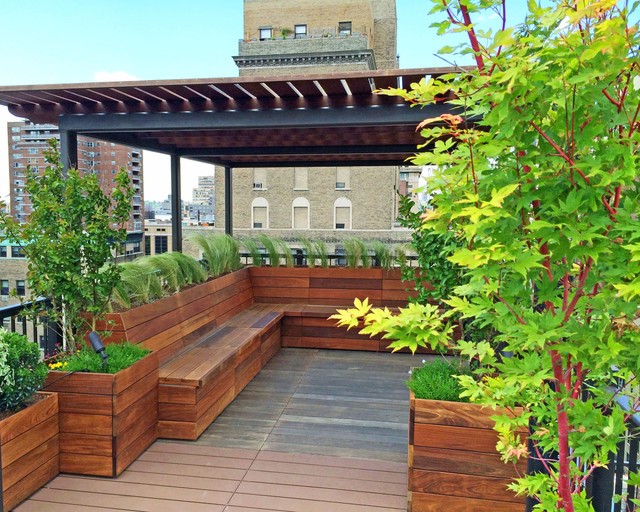From neighborhood restaurants to corporate-owned sports arenas, rooftop gardens are cropping up atop businesses nationwide. Why are these businesses literally going green? Because it pays in so many ways…
What Significant, Yet Untapped, Green Roof Benefits Could Your Business Reap?
Sewing a new path with a green roof can:
Get a Free Design Consultation 303-505-6669
- Save your business significant energy costs, cutting heat loss by 50%, shielding up to 88% of solar radiation and reducing AC costs as much as 25%.
- Lower urban air temperatures and improve air quality.
- Reduce carbon emissions and combat climate change.
- Reduce flash flooding, containing and repurposing water, and improving the quality of runoff.
- Reduce noise infiltration up to 40 db.
- Provide a habitat for wildlife that has been threatened by urban sprawl.
- Provide food for your restaurant, employees, or the community.
- Add valuable, usable space for guests and employees to enjoy.
- Improve employee engagement and productivity.
- Add curb appeal, drawing positive attention to your business, and turning it into a landmark.
A Look at Some Real Numbers
How much are businesses really saving from rooftop gardens? In 2001, Chicago’s City Hall was topped with 20,000 square feet of intensive and extensive vegetation. In August of the same year, researchers noted a rooftop temperature of 119°F atop the planted area, compared to the 169°F inferno registered on the black tar roof next door. In the time span from 2001 to 2008, the city saved an estimated $3,600 in annual cooling and heating costs. Today, Green Projects Administrator Michael Berkshire says the city’s green roof addition saves them $5,000/year on utility costs. If all the city’s roofs were similarly topped, officials believe peak energy demand could be reduced 720 megawatts (enough current for 750,000 consumers), and the load on the storm sewer system reduced about 70%. The city is now topping everything from offices to fire stations with greenery. Other big cities are following suit, including recent legislation by Denver to require green roofs on large new buildings.
Get a Free Design Consultation 303-505-6669
What Types of Greenery are Topping City Skylines?
Common approaches to green roofing include:
- Container Gardens
The easiest approach involves the use of containers and raised beds, holding everything from herbs and veggies to ornamental flowers and shrubs. - Semi-Intensive Green Roofs
Semi-intensive green roofs require more maintenance, but offer more flexibility of use. Planted with grass, ground covers and small shrubs, they will require occasional irrigation and maintenance, but are a great foundation for turning your rooftop into usable, natural square footage. - Intensive Green Roofs
Intensive green roofs hold a wider variety of vegetation, from grass, plants, shrubs and edibles, to small trees. Selection effects maintenance/irrigation. Properly planned and designed, it can provide a complete, stunning garden for guests/staff to relax. - Sedum Green Roofs
Sedum green roofs, though low-maintenance, aren’t made to be walked on. Rolled-out like a carpet, this roof is made of fragile succulents. - Biodiverse Roofing
The least common, biodiverse or ‘brown’ roofing is not typically constructed for pedestrian traffic, but to create a natural habitat for wildlife.
How to Build a Green Roof Space that’s User-Friendly & Safe
No matter which greenery you prefer, ensure rooftop garden success by seeking answers to the following questions:
- Are rooftop gardens allowed?
First, contact your city (and district leaders if your building is historical) to determine if building codes allow a rooftop garden/green roof system. - Can your existing roof handle the load?
Contact a structural engineer to determine the precise weight your current roof can carry. Soil, plants, and people can easily top 100-lbs/sq.ft. Saturated with rain/snow, they could be too much for the current structure. An engineer can advise you of workarounds and costs. - Do you have access?
How will you get materials and people in/out? Some cities require multiple entries/exits, emergency lighting, and fire alarms. - How will you water?
Hauling cans isn’t practical. However a rain barrel and drip irrigation may work if you don’t want to simply run a hose. - Will you add electrical?
Electricity makes life easier, allowing for safe passage and extending the times you will be able to use your rooftop garden. - Where will you store tools?
Maintenance tools, fertilizer, and compost take up space and are difficult to camouflage roof side. Options like bench seating and tables with storage can help. - How much sun do you get rooftop?
Do other building block out the sun? At what times of day? The plants chosen must reflect daily sun levels to ensure survival. - How hot is it?
Ambient heat from neighboring buildings/surfaces can cook plants – and people. How will you provide shelter? - Do you need a windbreak?
Strong winds can seriously injure plants. - How would you like to layout your rooftop garden?
Use graph paper for scale, considering the general organization of plants, garden furniture and features.
Gardening Time: The Best Ways to Trim Your Rooftop Garden Space
- Functional, Hardy Plants
Look to a landscape professional for help selecting the right species of greenery to achieve the results you desire. They can help you make the most of your space with vertical design (climbing vines, hanging baskets). A pro will also be more versed in plants friendly to the rooftop environment, growth tendencies (annuals vs. perennials; how large/quickly they grow), helping you ensure a lasting living design. - Flexible Furniture
Atop the roof, lightweight garden furniture is best for reducing the load on the roof. Foldable furniture may offer potential, as will double-duty furniture, such as plastic storage benches/tables. Create a focal point with your selections, deciding on a central gathering space. Be careful not to hide it with too many plants/decorations, and keep the color theme simple to avoid a ‘busy’ look. - Lightweight, Versatile Shelter
The people and plants on your rooftop garden need shelter. However a heavy wooden pergola won’t do. Luckily the lightweight aluminum construction of an Arcadia louvered pergola can be installed easily, and is a common rooftop addition. Capable of withstanding hurricane force winds, the Arcadia is perfectly at-home high above the sky, providing sun, shade, and reliable shelter from rain/snow with rapidly responding, iLouver app technology and weather-responsive programming.
There are Many Ways to Save on Your Commercial Rooftop Garden Installation
Depending on the greenery atop your roof, your business may be eligible for:
- Storm water fee discounts, due to reductions in runoff.
- Energy efficiency discounts from your local utility provider.
- Reduced HVAC costs. (Uncover how much with this free energy calculator from the Green Roofs for Healthy Cities Alliance)
- Development incentives (expedited permitting, zoning upgrades, increased floor area ratios).
- Grants for green infrastructure projects/practices.
- Rebates: Federal and local tax credits, reimbursement, and funding/financing may also be available.
- Awards and recognition, including monetary awards and free press, for exemplary projects.
- See the EPA’s Green Infrastructure Incentives Handbook to learn more, or research case studies here
Who says you can’t enjoy Mother Nature in the city? Enjoy all the benefits your rooftop garden has to offer. Open up to new possibilities with the help of Denver Pergola Systems today.
Visit one of our Pergola Show Rooms

1101 N. Santa Fe Dr
Denver, Colorado 20204
Hours: Tuesday-Saturday 10am-6pm
Creative Living
See A StruXure Pergola From Denver Pergola

950 Simms St,
Lakewood, Colorado 80401
Hours: Monday-Friday 10am-5pm
Saturday & Sunday 9am-5pm
Indoor Outdoor Spaces
Stop by and see a StruXure Pergola in person!

